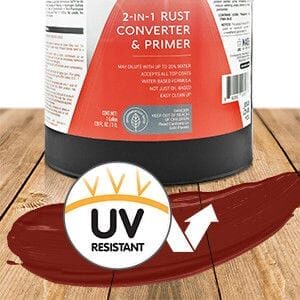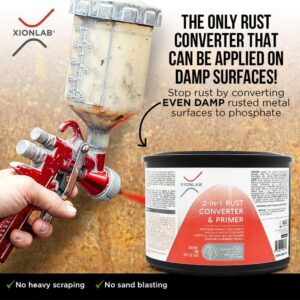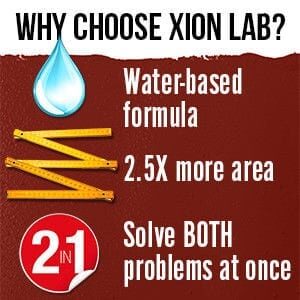No products in the cart.
Rust converters are mostly used to clean the rust off trailers, staircases, tanks, cars, etc. They are a chemical mixture that converts the rust on any metal item into a stable, black substance. This substance forms a great base for paint since it becomes a water-based primer. It forms a great base for oil or epoxy-based paints. The rust converter mixture is made from an organic polymer and Tannic acids that react with iron oxide (commonly known as rust).
However, the real question is, does rust converter work for everyday rusty items, as all homes have some objects or belongings covered in rust. To save high costs of replacement and deterioration, it is important to maintain such belongings. If the rust converters do work for such objects, then it better to use them rather than throw the object away or get a new one.
What is a Rust Converter?
 Before you can answer the question, “does rust converter work?” it is really important to first see what it is. Rust converters are made with Tannic acids and polymers. They react with iron oxide to form a stable, black polymeric coating on whatever object you are using. The coating forms a protective layer on the metal. It also makes for a great primer for oil or epoxy-based paints – a quality that makes it perfect for painting over. The paint also forms an additional layer of protection from future corrosion and rust.
Before you can answer the question, “does rust converter work?” it is really important to first see what it is. Rust converters are made with Tannic acids and polymers. They react with iron oxide to form a stable, black polymeric coating on whatever object you are using. The coating forms a protective layer on the metal. It also makes for a great primer for oil or epoxy-based paints – a quality that makes it perfect for painting over. The paint also forms an additional layer of protection from future corrosion and rust.
Rust removers work very differently from rust converters. Rust removers are acidic and can damage the metal. Experts prefer rust converters since they form a protective layer over the object and are perfect for painting. They hide any signs that rust ever existed and prevented future corrosion.
Does Rust Converter Work?
The two main ingredients in the formula, organic polymer and tannic acid, chemically react with iron oxide. Iron oxide forms when anything that contains iron like steel is exposed to oxygen for a long time. This creates a layer of rust that can corrode the iron. The rust converter reacts with this iron oxide to make an iron tannate. This looks like a black substance that is innate.
This tannin doesn’t hurt the item since it is soluble in water and alcohol. The tannins are found naturally in the grass, fruits, and trees. These organic items do not hurt the object, unlike rust removers.
The organic polymer is also known as 2-Butoxyethanol. This active ingredient is responsible for the protective layer that forms on the metal. This primer layer is perfect for paints made from oil or epoxy. It also prevents any corrosion or rust in the future, especially when painted over.
Rust converters are popular due to this primer and a protective layer on the iron. Unlike rust removers, it doesn’t merely remove the rust but turns it into a tool to protect from future corrosion. The natural ingredients in the rust converters like tannins also do not harm the metal. Rust removers can eat away at the metal since they are often highly acidic. It is important to be properly trained to use rust removers since any mistakes can result in holes in the metal.
So, does rust converter work for people? The answer is a definite, yes! This is because you just need to learn how to use it, and you can use it safely in the home. It also will not harm your belongings and is relatively easy to use.
What Can You Use A Rust Converter On?
 So now, it’s time to try out if rust converters work. Rust converters can only be used on steel or iron objects that have developed rust. It isn’t compatible with copper, stainless steel, or aluminum, as well as galvanized steel covered in zinc. You should also use it on items that you want to paint over since it leaves a black substance behind that perfectly with paint.
So now, it’s time to try out if rust converters work. Rust converters can only be used on steel or iron objects that have developed rust. It isn’t compatible with copper, stainless steel, or aluminum, as well as galvanized steel covered in zinc. You should also use it on items that you want to paint over since it leaves a black substance behind that perfectly with paint.
A lot of people also use rust converters on items that don’t have rust or iron to protect it in the future from corrosion. However, this doesn’t work since rust converters use rust to create a black, protective coating. Without the rust, there are no real means of protection.
You can use rust converters on any item made with iron like lawn equipment, mower decks, staircases, iron railings, vehicles, gates, fences, trailers, sheet metal, farm equipment, tanks, cast iron, tractors, and many others. This can help keep your belongings safe from harm.
Do Rust Converters Require Preparation?
So, does rust converter work? Yes, it does, but how exactly do you use it at home? They do require some surface preparation if you want a effective cleaning process. Surface preparation can enhance the rust converter’s abilities to efficiently cure the steel.
The first step to converting the rust is to remove any large rust or scale particles. You can use a stiff-bristled brush, sandpaper, or a hammer to remove the larger pieces. You don’t have to work hard as the goal isn’t to completely remove the rust, rather scrape off the loose bits. Make sure to leave some rust behind so that the rust converter can react with everything properly.
Rust converters cannot seep through and break oil or grease coatings. This is why it is important to first remove any grease or oil from the surface. You should also clean other contaminants like a layer of saltwater to make sure it does its job efficiently. Clean everything with freshwater and scrub to remove the grease. Make sure to let everything dry before you apply the rust converter. Rust converters are soluble in water and will not work efficiently around it.
How to Apply Rust Converters?
Does rust converter work? They do if they aren’t thinned. You need to use the mixture as it comes out of the bottle for an effective rust cleaning job. Make sure to stir or shake the bottle properly before using it since the formula can separate inside the bottle.
The best results for rust converters can be derived using a brush or roller to apply the formula on the iron. The rollers are usually recommended for larger surfaces like gates and trailers, while brushes can be used for smaller surfaces like iron railings or frames. You can also use the spray versions of rust converters, but it only works if you have an airless spray. This is because the oxygen in the air may affect the efficiency of the rust converter to react with the iron oxide.
Most people also confuse the amounts of rust converter to determine that they don’t work. However, you have to make sure the quantities you are using are correct. A 500 square feet of rusty iron surfaces will need around a gallon of rust converters for a thorough protective coating. Rust converters that come in sprays only cover around 300 square feet per gallon. We recommend that you don’t use aerosol rust converter sprays since they only cover 24 square feet per gallon. A heavier application may be a need for all of these if the surface of the object is porous, textured, or irregular.
It is also important to let the rust converter dry after the first application. Only add the second coating after making sure it is dry. The two coats will ensure that every bit of the rust is converted properly into a perfect protective coating. However, to ensure that the rust converter has reacted properly, make sure you wait for 48 hours before painting the object. This will ensure the curing process is thorough.
The oil or epoxy-based paint can be painted on easily after the curing is completed; however, before painting, wipe the surface of the metal with a damp cloth to remove the excess rust converter. The excess will come off easily since it is made from water-soluble ingredients. There is no need to invest in a primer for the paint since the rust converter forms a great layer of primer for the paint application.
If you follow these steps, you will know for sure whether the rust converter works.
Does Rust Converter Work without Painting?
It isn’t necessary to pain the iron surface after using the rust converter. However, experts recommend that you do paint the object. When the paint is mixed with the polymeric coating, it makes a protective layer that limits future corrosion and rust. This increases the overall safety of the object. Two coats of oil or epoxy-based paints can increase the overall coverage of protection. It also ensures that the rust conversion is complete.
This protective coating can protect the iron from all kinds of weather corrosions like direct sunlight, rain, and salt mist. If you live near coastal areas, you should try rust converters since there is a lot of salt in the air. The extra layer of paint with the rust converter will ensure that the paint doesn’t peel off or crack.
Water and latex-based paints don’t work well with rust converters since they don’t react properly with the black, polymer primer layer. It is better to use oil or epoxy paints since that reacts to protect your belongings from future corrosion and rust.
What Other Things Do I Need To Know?
 Does rust converter work? You can now try it out for yourself! Here are some helpful tips that will ensure that the rust conversion is effective and efficient.
Does rust converter work? You can now try it out for yourself! Here are some helpful tips that will ensure that the rust conversion is effective and efficient.
- Clean the application equipment with water and soap after using it. The mixture is water-soluble, so it will clean off easily.
- Rust converters aren’t heat resistant so avoid using them on the surface that will be heated like cars iron stoves, broilers, grills, engines, etc.
- It doesn’t work with metal that doesn’t contain iron like galvanized steel. This is because galvanized steel has a zinc coating to protect it. Rust converters need iron oxide to react properly.
- Do not use it on areas exposed to a lot of water like the insides of tanks as it is a water-soluble mixture. If you do use it, make sure to paint it properly with two coats.
- Rust converters only last for nine months on the shelf, even if you haven’t opened the bottle. Aerosol spray rust converters last for a year.
- Rust converters do not work under too low or high temperatures. Use them under temperatures between 50 to 100 Fahrenheit degrees.
- Do not put unused liquid back into the bottle after it is exposed to the air. This is because it may be contaminated and can ruin the rest of the mixture as well.
- Use safety goggles and chemically resistant gloves to prevent any mild irritations to the eyes and skin.
- It can stain clothes, so wear something old or inexpensive.
- If ingested, seek medical attention at once since it contains tannic acid. Keep away from pets, children, food, and water.
- Use rust converters in a well-ventilated area to limit fumes from the liquid. It is pretty light, like latex paints, but there is no need to take risks.
- Keep the rust converter out of high temperatures and direct sunlight. Do not freeze the mixture either since that can ruin the formula.
- Powder coating doesn’t mix well with the black primer coating that forms after using rust converters. Powder coating is mostly used for bare metals; hence, it is more effective to avoid using it with rust converters. If used, it begins to flake out and require extra work and costs to fix.
- Dispose of the rust converter according to state or federal guidelines. This is to ensure that it doesn’t hurt someone around your or the environment.
